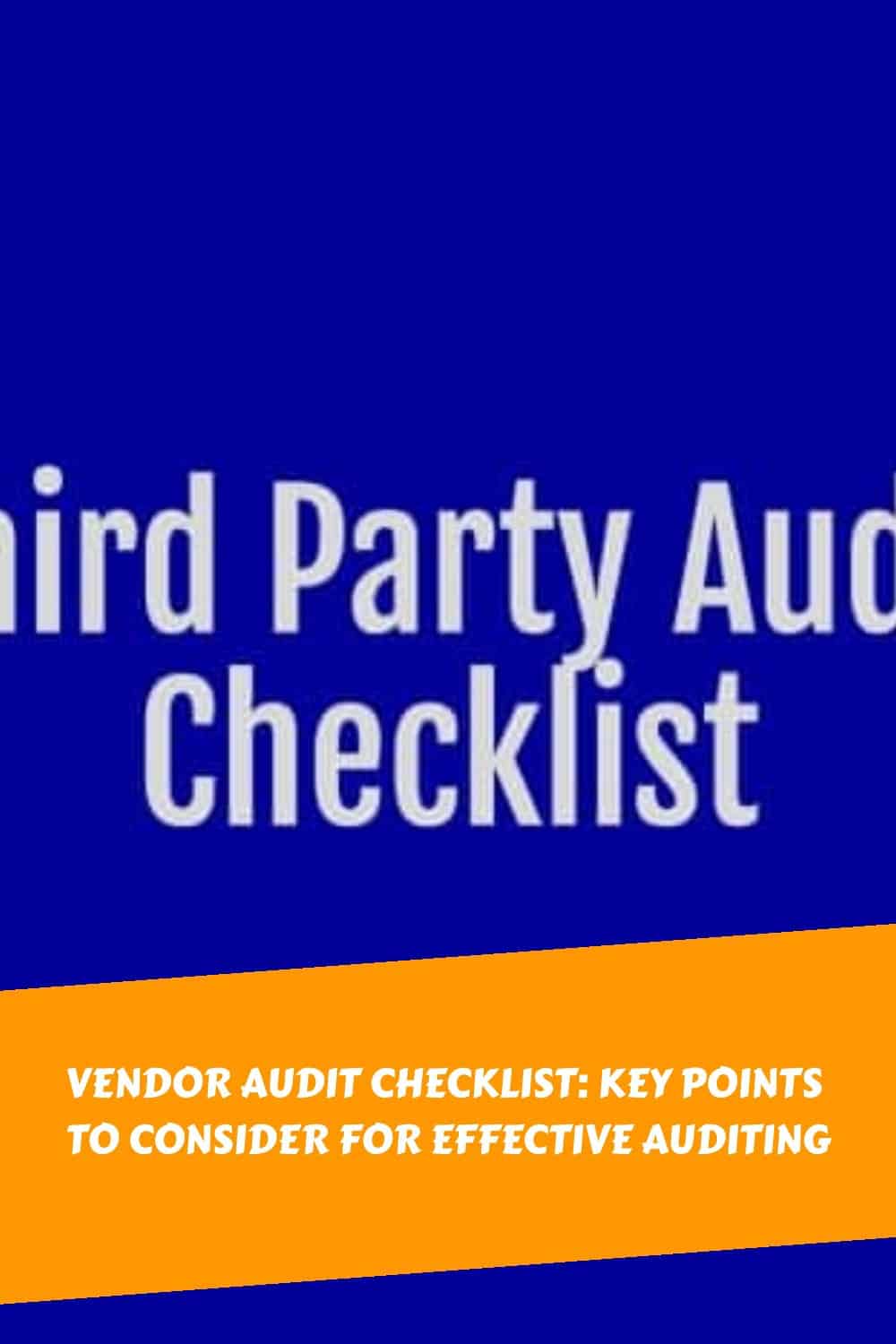Introduction
In my extensive experience as an auditor and IT security professional, I’ve found that a vendor audit checklist is not just a tool, but an essential instrument for effective auditing. It provides a systematic approach to evaluate a vendor’s processes and controls, ensuring they meet the required standards. This article will delve into the key points to consider for effective auditing using a vendor audit checklist.
Vendor audits are a crucial part of maintaining a secure and compliant business environment. They help identify potential risks and vulnerabilities in a vendor’s operations, which could impact the quality of their products or services. According to a recent study by the Institute of Internal Auditors, 58% of organizations have experienced a vendor-related incident that resulted in a financial loss. This statistic underscores the importance of thorough vendor audits.
A vendor audit checklist serves as a roadmap for the audit process, outlining the key areas to review and the specific criteria to assess. It ensures a consistent and comprehensive audit, reducing the likelihood of overlooking critical issues. The checklist can be tailored to suit the unique needs and risks of each vendor, making it a versatile tool for any auditor or IT security professional.
However, creating an effective vendor audit checklist requires a deep understanding of the vendor’s operations, industry standards, and regulatory requirements. It also requires a strategic approach to prioritize the areas of highest risk. In this article, I will share my insights and expertise to help you develop a robust vendor audit checklist.
Understanding the Third-Party Audit Process
The third-party audit process is a critical aspect of vendor management. It involves an independent assessment of a vendor’s operations to ensure compliance with regulatory requirements and industry standards. This process can be complex and time-consuming, but with a well-structured vendor audit checklist, it can be streamlined and made more efficient.
According to a report by Deloitte, 83% of organizations experienced a third-party incident in the past three years, yet only 1 in 4 have integrated risk management systems in place. This highlights the importance of understanding and effectively managing the third-party audit process.
The third-party audit process typically involves the following steps:
- Planning: This involves identifying the scope of the audit, defining the audit objectives, and developing the audit plan and checklist.
- Execution: The auditor conducts the audit according to the plan, using the checklist to guide the assessment and ensure all areas are covered.
- Reporting: The auditor documents the findings, including any non-compliances or areas for improvement.
- Follow-up: The auditor monitors the vendor’s progress in addressing the audit findings and verifies the implementation of corrective actions.
A vendor audit checklist can streamline this process by providing a clear and comprehensive framework for the audit. It ensures all relevant areas are assessed and helps maintain consistency across different audits. The checklist also serves as a valuable tool for documenting the audit findings and tracking the vendor’s progress in addressing these findings.
Benefits of Third-Party Audits
Third-party audits offer numerous benefits that contribute to a more secure and efficient business environment. From enhancing data security to improving business relationships, the advantages of third-party audits are manifold. According to a survey by PwC, 58% of companies plan to increase their use of third-party providers. This underscores the growing recognition of the value that third-party audits bring to businesses.
Here are some of the key benefits of third-party audits:
- Enhanced Data Security: Third-party audits help identify and address potential security vulnerabilities in a vendor’s operations, thereby enhancing data security. A study by Verizon found that 63% of data breaches involve a third party, highlighting the importance of third-party audits in data protection.
- Improved Compliance: Third-party audits ensure that vendors comply with regulatory requirements and industry standards, reducing the risk of non-compliance penalties.
- Better Vendor Performance: Regular audits encourage vendors to maintain high standards of performance and quality, leading to improved service delivery.
- Strengthened Business Relationships: Audits can foster transparency and trust between businesses and their vendors, strengthening their relationships.
While third-party audits require time and resources, the benefits they offer make them a worthwhile investment. By providing valuable insights into a vendor’s operations, they enable businesses to manage their vendor risks more effectively and make informed decisions that enhance their operational efficiency and business performance.
Vendor Audit Best Practices
Implementing vendor audit best practices is crucial for a successful audit. These practices range from setting clear audit objectives to maintaining open communication with the vendor. In my experience, adhering to these best practices has significantly improved the effectiveness of my vendor audits.
According to a report by Gartner, organizations that implement vendor risk management best practices are 2.5 times more likely to achieve their desired business outcomes. This statistic underscores the importance of following best practices in vendor audits.
Here are some of the vendor audit best practices that I recommend:
- Set Clear Audit Objectives: Clearly define the purpose and scope of the audit. This provides direction for the audit and helps ensure that all relevant areas are assessed.
- Use a Comprehensive Vendor Audit Checklist: A detailed checklist ensures a systematic and thorough audit. It should cover all areas of the vendor’s operations, from data security to regulatory compliance.
- Maintain Open Communication with the Vendor: Regular communication with the vendor can facilitate a smoother audit process. It helps build a collaborative relationship with the vendor and enables any issues to be addressed promptly.
- Document and Follow Up on Audit Findings: Documenting the audit findings provides a record of the vendor’s performance and any areas for improvement. Following up on these findings ensures that the necessary corrective actions are taken.
By implementing these best practices, auditors and IT security professionals can conduct more effective and efficient vendor audits. This not only enhances the value of the audit but also contributes to better vendor management and risk mitigation.
Third-Party Audit Requirements
Understanding third-party audit requirements is key to ensuring a thorough and compliant audit. These requirements may vary depending on the industry and the specific nature of the vendor’s services. However, there are some common requirements that are typically included in most third-party audits.
According to a report by the Shared Assessments Program, 53% of organizations have experienced a data breach caused by a third-party vendor. This statistic highlights the importance of meeting third-party audit requirements to mitigate vendor risks.
Here are some of the common third-party audit requirements:
- Data Security: Vendors must have robust data security measures in place to protect sensitive data. This includes encryption, access controls, and regular security testing.
- Regulatory Compliance: Vendors must comply with all relevant regulations, such as the General Data Protection Regulation (GDPR) for data privacy or the Sarbanes-Oxley Act for financial reporting.
- Operational Efficiency: Vendors should demonstrate efficient operations, including timely delivery of services and effective issue resolution processes.
- Financial Stability: Vendors should have sound financial health to ensure their long-term viability and reliability.
These requirements should be incorporated into your vendor audit checklist to ensure a comprehensive audit. By meeting these requirements, vendors can demonstrate their commitment to quality, compliance, and security, thereby building trust and confidence with their clients.

Conclusion
Conducting a third-party audit or vendor audit can indeed be a complex task. The intricacies of vendor operations, the nuances of industry standards, and the rigors of regulatory requirements all contribute to this complexity. However, with a comprehensive vendor audit checklist and a clear understanding of the audit process, benefits, best practices, and requirements, auditors and IT security professionals can effectively manage vendor risks and improve their business operations.
According to a study by the Ponemon Institute, the average cost of a data breach involving a third party is $4.29 million, a figure that underscores the financial implications of vendor risks. By conducting thorough vendor audits, businesses can not only mitigate these risks but also enhance their operational efficiency, data security, and regulatory compliance.
In my experience, the key to a successful vendor audit lies in meticulous planning, systematic execution, and diligent follow-up. By adhering to the best practices and requirements outlined in this article, you can conduct effective vendor audits that deliver valuable insights and drive continuous improvement in your vendor management processes.









